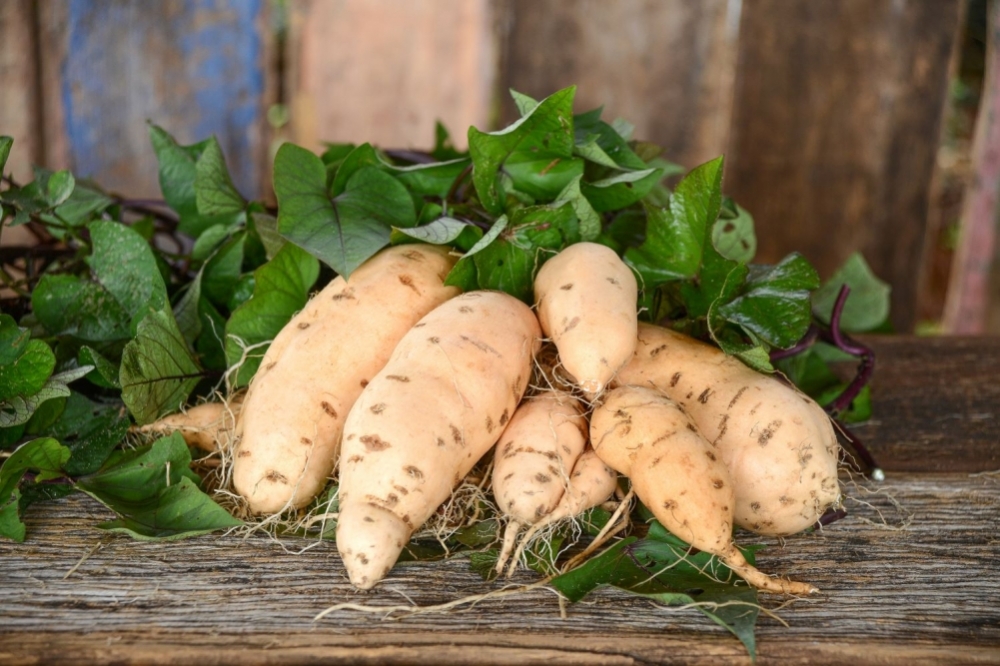

Research groups in São Paulo state and Mozambique analyzed carotenoids in over 1,000 sweet potatoes and found some with 88% more beta-carotene, a precursor of vitamin A (photo: Pablo Forlan Vargas/FCAVR-UNESP)
Research groups in São Paulo state and Mozambique analyzed carotenoids in over 1,000 sweet potatoes and found some with 88% more beta-carotene, a precursor of vitamin A.
Research groups in São Paulo state and Mozambique analyzed carotenoids in over 1,000 sweet potatoes and found some with 88% more beta-carotene, a precursor of vitamin A.

Research groups in São Paulo state and Mozambique analyzed carotenoids in over 1,000 sweet potatoes and found some with 88% more beta-carotene, a precursor of vitamin A (photo: Pablo Forlan Vargas/FCAVR-UNESP)
By André Julião | Agência FAPESP – Since 2012, agronomist Pablo Forlan Vargas has traveled much of the Ribeira Valley region in Brazil in search of the perfect sweet potato. Vargas is a professor at São Paulo State University’s Ribeira Valley School of Agrarian Sciences (FCAVR-UNESP) in Registro, a municipality he is exploring in the region along with others across São Paulo state, such as Vera Cruz, Botucatu, Jaboticabal and Ilha Solteira.
For Vargas, the perfect sweet potato would be easy to grow, pest- and drought-resistant, a good shape (oval and not too elongated), with plenty of dry matter (which boiling does not dissolve) and above all high levels of beta-carotene, a red-orange pigment that is a precursor of vitamin A. Children in the Ribeira Valley were vitamin A-deficient when the project began.
Eleven years on, having received three grants from FAPESP and partnered with the Mozambique unit of the International Potato Center (CIP), Vargas has just launched three cultivars (cultivated varieties) richer in beta-carotene and other carotenoids than the commercial variety available in Brazil known to have the highest levels of the pigment.
The three cultivars were officially launched at an event held on May 8 in the auditorium of UNESP’s Center for Tropical Roots and Starches (CERAT) in Botucatu, where Vargas is a research associate. The plants will be distributed free of charge to producers, mostly smallholders who grow subsistence crops and in some cases market relatively small volumes.
“This is a technology we’re transferring to society. The varieties are easy to grow with a high yield and require simple management, although the yield may be higher if more care is taken,” Vargas said, noting that large producers can also benefit from the technology.
He currently has another grant from FAPESP. After the first project, he again received funding from FAPESP.
Biofortified
Analysis of carotenoids was led by Maria Isabel Andrade, a scientist affiliated with CIP Mozambique. For over 20 years, she has cross-bred and selected sweet potatoes to create biofortified varieties.
The research won her and her team the 2016 World Food Prize, which recognizes and rewards individuals who advance human development by raising the quality, quantity or availability of food in the world.
Andrade also supplied varieties to CERAT’s repository, which mainly comprises plants collected in São Paulo state. After carotenoid levels were analyzed, the 25 most biofortified varieties were selected and grown with a view to measuring traits such as shape, yield, drought and pest resistance, among others.
“CIP is headquartered in Lima [Peru] and has units in other countries. Its expertise in the field is vast. We realized we needed help from professionals like Professor Maria Isabel Andrade in order to achieve results fast enough to make a difference to the communities we visited,” Vargas said.
Compared with the carotenoid-rich Beauregard variety, developed in the 1980s in the United States and available in Brazil, the three champions of the Brazilian-Mozambican project have far higher levels of the pigment.
One of the three cultivars was found to have 112.49 micrograms of carotenoids per gram, 88% more than the Beauregard (59.58 mcg/g). The others had 105.04 and 70.41 mcg/g, also significantly more than the US variety.
Vitamin A deficiency contributes to health problems such as blindness, diarrhea, immune system disorders, and premature deaths of newborns and pregnant women. The researchers hope that the results of the study will bolster the supply of a cheap source of vitamin A and reduce the occurrence of these problems.
Every year Vargas and his team participate in the Ribeira Valley Quilombola Seed and Seedling Fair. Quilombos were rural communities organized in the sixteenth to nineteenth centuries by enslaved Africans who managed to escape their owners. Their descendants are known as quilombolas. At the fair, they exchange seeds, foliage and seedlings for different crops as a way of maintaining the diversity of food crop species in the region.
In addition to sweet potatoes collected locally by the researchers, they can now offer an African “cousin” to enrich the diet of people living in São Paulo.
Republish
The Agency FAPESP licenses news via Creative Commons (CC-BY-NC-ND) so that they can be republished free of charge and in a simple way by other digital or printed vehicles. Agência FAPESP must be credited as the source of the content being republished and the name of the reporter (if any) must be attributed. Using the HMTL button below allows compliance with these rules, detailed in Digital Republishing Policy FAPESP.





